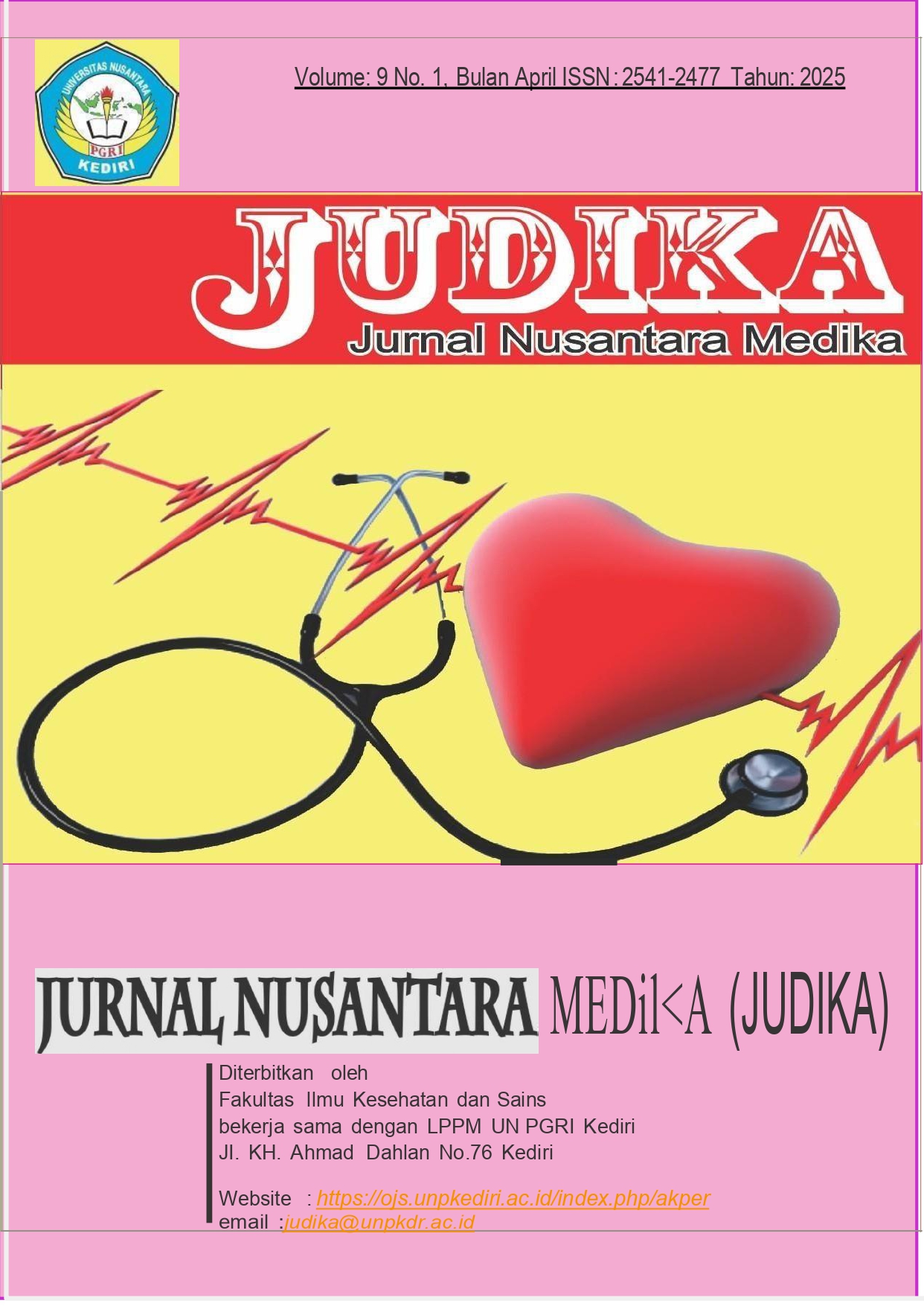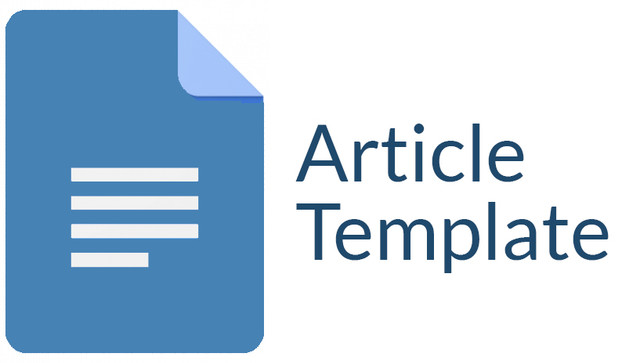OPTIMASI SUHU DAN WAKTU PENGERINGAN SIMPLISIA DAUN TELANG SEBAGAI KANDIDAT ANTIBAKTERI ALAMI
DOI:
https://doi.org/10.29407/judika.v9i1.25200Keywords:
daun telang, optimasi, suhu, waktu, simplisiaAbstract
Infeksi nosokomial merupakan ancaman serius bagi rumah sakit saat ini. Staphyloccus aureus dan Escherichia coli merupakan contoh bakteri penyebab infeksi nosokomial. Penggunaan antibiotik justru memicu terjadinya resistensi pada beberapa mikroba penyebab infeksi, sehingga dibutuhkan alternatif seperti bahan alami sebagai antibakteri. Daun telang merupakan tanaman biodiversitas daerah Kediri, Jawa Timur yang dikenal memiliki sifat antibakteri. Tujuan penelitian adalah menemukan suhu dan waktu optimum dalam pembuatan simplisia daun telang sebagai bahan antiseptik alami. Metode yang digunakan dalam penelitian ini adalah pengeringan daun menggunakan oven. Rentang suhu penelitian adalah 40ºC, 45ºC dan 50ºC.Sedangkan rentang waktu pengeringan yang digunakan adalah 30,60, 90, 120,150, 180 dan 210 menit. Hasil penelitian menunjukkan kondisi pengeringan daun telang yang optimum sebagai bahan simplisia adalah pada suhu 50ºC dan waktu pengeringan 120 menit.
Downloads
References
1. Blatnik P, Bojnec Š. 2023. Analysis Of Impact Of Nosokomial Infections On Cost Of Patient Hospitalisation. Cent Eur J Public Health, 31(2): 90–6.
2. Chakraborty, S., Sahoo, S., Bhagat, A., & Dixit, S. 2017. Studies On Antimicrobial Activity, Phytochemical Screening Tests, Biochemical Evaluation Of Clitorea. International Journal Of Research – Granthaalayah, 5(1):197–208.
3. Dixa S, Singh V.S. 2016. Isolation and Characterization of Flavonoids in Urena lobata L. Eurpean Journal of Medicinal Plants, 1: 1- 6.
4. Gidey Mt, Hailu By. 2023. Clinical And Economic Burden Of Healthcare- Associated Infections : A Prospective Cohort Study. Plos One, 18(2):1–11
5. Khumairoh, L., Susilo, J., & Laila Vifta, R. 2020. Perbedaan Pelarut Etanol 96% dan Etil Asetat Pada Uji Aktivitas Antibakteri Ekstrak Bunga Telang (Clitoria ternatea L) terhadap Propionibacterium acnes. Doctoral dissertation, Universitas Ngudi Waluyo.
6. Konoralma, Ketrina. 2019. Identifikasi Bakteri Penyebab Infeksi Nosokomial Di Rumah Sakit Umum Gmim Pancaran Kasih Manado. Jurnal Kesmas, 8(1): 23-35.
7. Kurniati Ps, Heriyani F, Budiarti Ly, Studi P, Dokter P, Kedokteran F, Et Al. 2019. Gambaran Jenis Bakteri Pada Tangan Siswa Sekolah. Homeostasis, 2(1): 99–106.
8. Lindayani, Novena Yety dan Ma’ruf, Sabilla Hudzaifah. 2020. Penetapan Kadar Total Flavonoid Ekstrak Etanol Kacang Merah (Phaseolus vulgaris L.) dengan Metode Kompleks Kolorimetri Secara Spektrofotometri Visibel. Jurnal Ilmiah Manuntung, 6(1), 83-91.
9. Mancuso G, Midiri A, Gerace E, Biondo C. 2021. Bacterial Antibiotic Resistance : The Most Critical Pathogens. Pathogens, 10(1310): 1–14.
10. Mulangsri, D. A. K. 2019. Penyuluhan Pembuatan Bunga Telang Kering Sebagai Seduhan Teh Kepada Anak Panti Asuhan Yatim Putra Baiti Jannati. Abdimas Unwahas, 4(2): 93–96.
11. Muller J, Heindl. Drying Of Medical Plants In R.J. Bogers, L.E.Cracer, and Lange D, (eds). 2006. Medical and Aromatic Plant. The Netherland: Springer : 237-252
12. Purwaniati, Arif, A. R., & Yuliantini, A. 2020. Analisis Kadar Antosianin Total Pada Sediaan Bunga Telang (Clitoria ternatea) Dengan Metode pH Diferensial Menggunakan Sprektrofotometri Visible. Jurnal Farmagazine, 7(1), 18–23.
13. Rahmawati, Susi; Abdul, Ahwan; Qonitah, Fadilah. 2022. Perbandingan Aktivitas Antibakteri Ekstrak Etanol dan Metanol Daun Bunga Telang (Clitoria ternatea L.) Terhadap Escherichia coli Esbl (Extended Spectrum Beta Lactamase). Jurnal Jamu Indonesia, 7(2): 72-79.
14. Stewart S, Robertson C, Pan J, Kennedy S, Haahr L, Manoukian S, Et Al. 2021. Impact Of Healthcare-Associated Infection On Length Of Stay. J Hosp Infect, 114: 23–31.
Downloads
Published
Issue
Section
License
Copyright (c) 2025 Elysabet Herawati, Endah Tri Wijayanti, Dwi Ari Budiretnani

This work is licensed under a Creative Commons Attribution-ShareAlike 4.0 International License.
Authors who publish with this journal agree to the following terms:
- Copyright on any article is retained by the author(s).
- The author grants the journal, right of first publication with the work simultaneously licensed under a Creative Commons Attribution License that allows others to share the work with an acknowledgment of the work’s authorship and initial publication in this journal.
- Authors are able to enter into separate, additional contractual arrangements for the non-exclusive distribution of the journal’s published version of the work (e.g., post it to an institutional repository or publish it in a book), with an acknowledgment of its initial publication in this journal.
- Authors are permitted and encouraged to post their work online (e.g., in institutional repositories or on their website) prior to and during the submission process, as it can lead to productive exchanges, as well as earlier and greater citation of published work.
- The article and any associated published material is distributed under the Creative Commons Attribution-ShareAlike 4.0 International License













